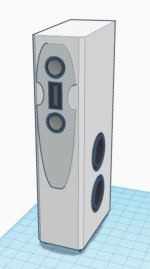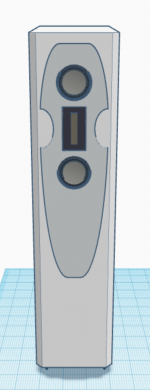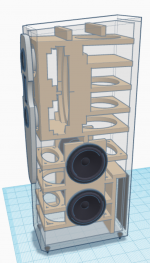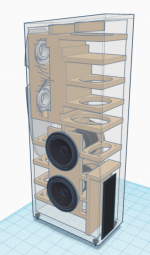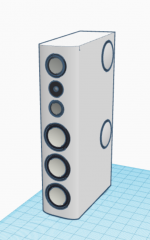So recently I have been making concepts for what I suspect will be in my (living)room within ten years. These is the idea I have: a 3-way with MTM on the front and opposite side mounted active (sub)woofers. I have a list of potential drivers from different types, materials and so tastes:
Tweeter:
-Soft
Scan-Speak Revelator D2904/710003
Scan-Speak Ellipticor D3404/552000
Seas Excel T29CF002
Scan-Speak Illuminator D3004/662000
-Beryllium
Scan-Speak Revelator D2908/714000
Scan-Speak Illuminator D3004/664000
SB-Acoustics Satori TW29BN-B
-Ceramic
Accuton C25-6-158
-Ribbon
AST25120
Aurum Cantus G3
Midranges:
-Paper
2: Scan-Speak Ellipticor 18WE/4542T00
2: SB-Acoustics Satori MR16P-4
2: Scan-Speak Revelator 15M/4531K00
2: Scan-Speak Illuminator 15WU/4741T00
2: Seas Excel W18NX001
-Metal
2: Seas Excel W15CY001
-Ceramic
2: Accuton C90-6-724
2: Accuton C173-6-090
(Sub)woofers:
-Paper
2: Scan-Speak Revelator 32W/4878T00
4: SB-Acoustics Satori WO24P-8
-Metal
4: Scan-Speak Revelator 26W/4867T00
They are sorted from what I think will most likely be the one I chose to least likely. My current system exists of a beryllium tweeter with paper midrange and woofers. But when I'm going to build something like this, I think I will eventually prefer hard ceramic midranges because they still offer that nice damping and snap like that of paper cones, but also offer way better clarity, detail and especially the Accuton drivers offer superior transient response, even in comparison to the Satori or Ellipticor drivers. And what I most like about the Accuton C90-6-724, is it's sort of open-back design, with no motor behind the cone. This in my design of the midrange chamber will offer an insane soundstage. To combine with the open-back midrange, I thought the Aurum Cantus AST25120, which is also an open-back tweeter and has that huge ribbon surface area and dispersion. And because it's a ribbon, it should nicely pair with the transparency, detail and transient response of the Accutons. The combination of this upper-section should give enormous soundstage, clarity and it won't get much more detailed and faster. To combine with the hard cones, the woofers will be four Scan-Speak Revelator 26W/8867T00's in a sealed box, driven by a Hypex FA252.
The centre-point of the upper section will be at a perfect ear-height of 107,5 cm from the floor. The midrange chamber will be huge, around 25 L and with a acoustically optimized shape, braking up the back wave, minimizing the need for damping material, to give those midranges more than enough air to breath in for practically no compression and a even huger, airier soundstage. This sort of midrange chamber worked very well with my current speakers. The entire system will be based on active crossovers. The tweeters and midranges will be driven by individual external amplifiers, which will be connected to a MiniDSP 10x10 HD.
Tell me what you think.
Tweeter:
-Soft
Scan-Speak Revelator D2904/710003
Scan-Speak Ellipticor D3404/552000
Seas Excel T29CF002
Scan-Speak Illuminator D3004/662000
-Beryllium
Scan-Speak Revelator D2908/714000
Scan-Speak Illuminator D3004/664000
SB-Acoustics Satori TW29BN-B
-Ceramic
Accuton C25-6-158
-Ribbon
AST25120
Aurum Cantus G3
Midranges:
-Paper
2: Scan-Speak Ellipticor 18WE/4542T00
2: SB-Acoustics Satori MR16P-4
2: Scan-Speak Revelator 15M/4531K00
2: Scan-Speak Illuminator 15WU/4741T00
2: Seas Excel W18NX001
-Metal
2: Seas Excel W15CY001
-Ceramic
2: Accuton C90-6-724
2: Accuton C173-6-090
(Sub)woofers:
-Paper
2: Scan-Speak Revelator 32W/4878T00
4: SB-Acoustics Satori WO24P-8
-Metal
4: Scan-Speak Revelator 26W/4867T00
They are sorted from what I think will most likely be the one I chose to least likely. My current system exists of a beryllium tweeter with paper midrange and woofers. But when I'm going to build something like this, I think I will eventually prefer hard ceramic midranges because they still offer that nice damping and snap like that of paper cones, but also offer way better clarity, detail and especially the Accuton drivers offer superior transient response, even in comparison to the Satori or Ellipticor drivers. And what I most like about the Accuton C90-6-724, is it's sort of open-back design, with no motor behind the cone. This in my design of the midrange chamber will offer an insane soundstage. To combine with the open-back midrange, I thought the Aurum Cantus AST25120, which is also an open-back tweeter and has that huge ribbon surface area and dispersion. And because it's a ribbon, it should nicely pair with the transparency, detail and transient response of the Accutons. The combination of this upper-section should give enormous soundstage, clarity and it won't get much more detailed and faster. To combine with the hard cones, the woofers will be four Scan-Speak Revelator 26W/8867T00's in a sealed box, driven by a Hypex FA252.
The centre-point of the upper section will be at a perfect ear-height of 107,5 cm from the floor. The midrange chamber will be huge, around 25 L and with a acoustically optimized shape, braking up the back wave, minimizing the need for damping material, to give those midranges more than enough air to breath in for practically no compression and a even huger, airier soundstage. This sort of midrange chamber worked very well with my current speakers. The entire system will be based on active crossovers. The tweeters and midranges will be driven by individual external amplifiers, which will be connected to a MiniDSP 10x10 HD.
Tell me what you think.
Attachments
Very nice design, but I would put the woofers in separate boxes as woofers and tops have different placement requirements to sound best. And I would not put them isobaric btb, but 2 in a box btb (to cancel forces) with a divider.
If you make the tops (mid/high) as narrow as possible and with well rounded corners, you will have the best/least baffle reflections and best horizontal off axis response.
I prefer tweeters with a cylindrical wavefront as they put out the sound where you want it, often have a very good hor. off axis response and a smooth detailed sound.
If you make the tops (mid/high) as narrow as possible and with well rounded corners, you will have the best/least baffle reflections and best horizontal off axis response.
I prefer tweeters with a cylindrical wavefront as they put out the sound where you want it, often have a very good hor. off axis response and a smooth detailed sound.
If you make the tops (mid/high) as narrow as possible and with well rounded corners, you will have the best/least baffle reflections and best horizontal off axis response.
Interesting. I tend to make the baffle as wide as possible. That most of the sound is actually radiating forward. With thin baffles a lot of sound also radiates to the back. Radiation towards the back only means more room troubles.
Nice big roundovers do help alot with diffraction.
To OP: You seem to be very focussed upon step response and nonlinear distorton. While I agree that those are very important parameters, I wonder if you also pay attention to off axis response?
What is your plan for crossovers? Fully digital? Analog active or normal passive crossovers? This also has alot of impact on the time-domain measurements. Especially passive notch filters.
It's not really isobbaric, it's just sealed with woofer in both sides of the cabinet.
I'll be crossing the C90 at about 3 kHz,where it still has good off axis response and also some headroom for the crossover roll-of. And then the ribbon tweeter should give amazing horizontal of axis response over a very high bandwidth.
Crossovers will be completely active.
I'll be crossing the C90 at about 3 kHz,where it still has good off axis response and also some headroom for the crossover roll-of. And then the ribbon tweeter should give amazing horizontal of axis response over a very high bandwidth.
Crossovers will be completely active.
Last edited:
Ribbons do give amazing horizontal dispersion, their vertical dispersion is horrible though. The vertical dispersion of d'appolito isn't too great as far as I know. This is also why I am a bit skeptical about the ellipticor tweeter.
Then again I am not a fan of ribbons and d'appolito. I prefer a good 2 or 3-way system.
If you are going for the ellipticor drivers, please let me know. I am considering them as well for my project. Still in doubt because they are crazy expensive. I haven't had the chance to listen to them before.
Though if your dream setup contains the Accuton midranges, I recommend those. They are a bit more expensive, but if you have money for 2 ellipticor drivers, this shouldn't be a problem.
Then again I am not a fan of ribbons and d'appolito. I prefer a good 2 or 3-way system.
If you are going for the ellipticor drivers, please let me know. I am considering them as well for my project. Still in doubt because they are crazy expensive. I haven't had the chance to listen to them before.
Though if your dream setup contains the Accuton midranges, I recommend those. They are a bit more expensive, but if you have money for 2 ellipticor drivers, this shouldn't be a problem.
I personally do believe in MTM because I think the perfectly centered acoustic centre should give amazing imaging, and iglf you look at all the great brands, there's quite a lot of the best brands in the world who use MTM even in their flagship speakers: Wilson Audio, YG Acoustics, Kroma Audio (in a way), Tidal, Bon Schweikert, The Gryphon, Burmester Audio, Egglestonworks, Marten Audio, Audio Solutions (not in their flagship though), Focal, Dynaudio, Monitor Audio, Avid Audio and probably even more.
You shouldn't copy things because (in)famous brands use that technology. You should use a certain technology because it meets a design requirement. In this case, your believe of the acoustic center.
I personally think phase issues should be covered in digital domain. Since linear phase/minimum phase can be made much easier and more accurate than analog filters (in my opinion). Also the time-allignment of the drivers is much easier to do in digital domain.
The reason to go d'appolito is that you want a symmetrical vertical dispersion (regardless of huge peaks, because thats what d'appolito also gives).
I don't want to hold you back from d'appolito, I just want you to know that (as far as I know) all designs have downsides and upsides. It's okay if you choose a certain design, just know that you are making a compromise between certain parameters.
I do not understand what parameters you find important as you haven't written them down and since you are spending thousands of euro's on this design, I think you should write down what you want to achieve before you eliminate certain aspects in your driver comparison.
I personally think phase issues should be covered in digital domain. Since linear phase/minimum phase can be made much easier and more accurate than analog filters (in my opinion). Also the time-allignment of the drivers is much easier to do in digital domain.
The reason to go d'appolito is that you want a symmetrical vertical dispersion (regardless of huge peaks, because thats what d'appolito also gives).
I don't want to hold you back from d'appolito, I just want you to know that (as far as I know) all designs have downsides and upsides. It's okay if you choose a certain design, just know that you are making a compromise between certain parameters.
I do not understand what parameters you find important as you haven't written them down and since you are spending thousands of euro's on this design, I think you should write down what you want to achieve before you eliminate certain aspects in your driver comparison.
Just red an article about D'Appolito on Wikipedia. Now I understand the problems and they do indeed seem pretty bad considering I could just go with a TM and have them aligned perfectly digitally. Maybe a MT is better after all for this application. But in that case I the driver selection that's more likely to be the one is the Scan-Speak Revelator D2908/714000 with the Accuton C173-6-090 and then with the Scan-Speak Revelator 26W/8867T00's again. Because that tweeter is pretty much the best hard dome tweeter in existence right now and it will match the sound of the Accuton very well. The C173-6-090 because when going with a single midrange I do want a bigger driver since it has lower distortion, much higher sensitivity and most importantly bigger Sd, I really do desire a big midrange cone area to give that full, snappy, and deep midrange with body to it.
There are 2 D3004/6640 tweeters on ebay for quite "cheap" (±600euro) at the moment if you are in a rush. They are quite similar to the relevator variant, based on distortion graphs.
Try to focus more on design specifications. Otherwise you keep searching and searching for drivers, but you never know which one is the best for your design! I know it's fun to drool over some super expensive driven with incredible specs, but sooner or later there will be better drivers/amplifiers/dsp's/whatever. You'll have to settle for something that is enough. Especially while spending several thousands on speakers, money doesn't grow on trees.
A good design with mediocre parts can perform better than a poor design with super high end parts.
If you want a low distortion high Sd woofer, you might wanna check out the SEAS W22EX/001.
Try to focus more on design specifications. Otherwise you keep searching and searching for drivers, but you never know which one is the best for your design! I know it's fun to drool over some super expensive driven with incredible specs, but sooner or later there will be better drivers/amplifiers/dsp's/whatever. You'll have to settle for something that is enough. Especially while spending several thousands on speakers, money doesn't grow on trees.
A good design with mediocre parts can perform better than a poor design with super high end parts.
If you want a low distortion high Sd woofer, you might wanna check out the SEAS W22EX/001.
That W22EX001 is indeed very big but it doesn't have to be that huge. A 6,5" is big enough. And anyway, that thing isn't usable as mid in a 3-way unless you have a tweeter that goes exceptionally low, or I'm gonna have to get into horns and waveguides but I don't want any of that. So if I where to use magnesium Seas Excel drivers is would be the W18EX001. But also that is still usable to only 1,5 kHz. If I would really want to use that one it could be done with the SB-Acoustics Satori TW29BN-B. But if I would want that sort of driver I would still probably use the Accuton since magnesium and ceramics are somewhat similar in their sound signature. They are both very hard but very lightweight and well self-damped and deliver a nice snap which I can confirm often having heard the Grimm LS1Be. So the materials are pretty similar in sound characteristics, though. Ceramics handle breakup way better and are usable to way higher frequencies, and in particular the Accuton drivers are even lower distortion (not that the Seas Excel don't have low distortion already) and are even faster (not that the Seas Excel aren't fast already).
I think the Grimm LS1Be (with DMF sub) is kind of in their own league at the moment. They use the SEAS woofer as a midrange and it sounds wonderful. Though they use lot's of trickery to make it work (custom tweeters, current driven woofers).
You state that 8" is too big and 6.5" is not. Would 7" (like the ellipticor's) be okay? Where is the border and why is this the border?
You want a nice impulse/step response? Try look at burst decay graphs. A strong motor also greatly helps, but make sure to define the line!
For instance: "the non linear distortion of the tweeter should not exceed 2% within a range of 2kHz to 20kHz".
It's simple to measure and you can eliminate tons of parts like this. It saves you a lot of time and in the end you have a clear idea of what you've built.
We can not make requirements for you, but we can assist you in driver selection and technical stuff. If you don't state requirements, then you'll either get vague audiophile terms like 'This tweeter sounds very warm, creates lots of depth and doesn't sound harsh" or you get responses that are perhaps completely irrelevant.
Asking for feedback is good, but what do you expect for an answer?
You state that 8" is too big and 6.5" is not. Would 7" (like the ellipticor's) be okay? Where is the border and why is this the border?
You want a nice impulse/step response? Try look at burst decay graphs. A strong motor also greatly helps, but make sure to define the line!
For instance: "the non linear distortion of the tweeter should not exceed 2% within a range of 2kHz to 20kHz".
It's simple to measure and you can eliminate tons of parts like this. It saves you a lot of time and in the end you have a clear idea of what you've built.
We can not make requirements for you, but we can assist you in driver selection and technical stuff. If you don't state requirements, then you'll either get vague audiophile terms like 'This tweeter sounds very warm, creates lots of depth and doesn't sound harsh" or you get responses that are perhaps completely irrelevant.
Asking for feedback is good, but what do you expect for an answer?
I have no problem with 8" being too big, it's just that I prefer relatively high crossover frequencies like 3 kHz or even higher when possible and I do believe good 8" driver will have pretty decent transparency and transient response but it's impossible for them to offer the same kind of transparency, detail and transient response as < 7" drivers.
And yeah 7" is still good, 6,5" and 7" aren't that much different are they? And I think the tweeter distortion definitely shouldn't exceed 2% above 2 kHz. All beryllium tweeters on my list actually stay under 1%.
And yeah 7" is still good, 6,5" and 7" aren't that much different are they? And I think the tweeter distortion definitely shouldn't exceed 2% above 2 kHz. All beryllium tweeters on my list actually stay under 1%.
I know, you can't. But I think it's common sense that a bigger moving mass can't offer the same of those characteristics, no matter how strong it's motor. And I think I can get a very good impression of what specific driver sound like based on the way they look, the brand that made them, (cone)materials and some measurements having heard many different driver brands, knowing what their drivers sound like and how that sound will translate in their certain models.
For example, the Scan-Speak Revelator mid woofers offer some pretty good transparency and clarity, but they mostly shine in having a very nice weight and snap to them. The Illuminators I think are a bit tighter and faster and offer slightly better transparency and especially clarity, but at the cost of some of that weightiness. The Ellipticor sit somewhere in the middle between but a bit fuller and yet the fastest and of the bunch.
For example, the Scan-Speak Revelator mid woofers offer some pretty good transparency and clarity, but they mostly shine in having a very nice weight and snap to them. The Illuminators I think are a bit tighter and faster and offer slightly better transparency and especially clarity, but at the cost of some of that weightiness. The Ellipticor sit somewhere in the middle between but a bit fuller and yet the fastest and of the bunch.
Nice project that you're starting !
As tweeter the Viawave GRT-145 is also very good.
I've just finished my Refspeaker V2,
I made larger bass cabinets to get more 25-40Hz output.
The Accuton C173-6-090 mids also got bigger cabinets,
I went from a 4 liter closed box to a 10 liter aperiodic vented cone shaped box.
With the small closed box I didn't get the Accutons to sound completely good (nasal),
I suspect it was due to the backwaves of the cone bouncing around in the closed box.
Now with the 10 liter cone shape tapered box (45cm long), the backwave is completely absorbed.
It sound much more natural, open and dynamic, here some pictures.
My findings correspond to Troels ones, see halfway "Mid cab vent"
Regards,
Danny
As tweeter the Viawave GRT-145 is also very good.
I've just finished my Refspeaker V2,
I made larger bass cabinets to get more 25-40Hz output.
The Accuton C173-6-090 mids also got bigger cabinets,
I went from a 4 liter closed box to a 10 liter aperiodic vented cone shaped box.
With the small closed box I didn't get the Accutons to sound completely good (nasal),
I suspect it was due to the backwaves of the cone bouncing around in the closed box.
Now with the 10 liter cone shape tapered box (45cm long), the backwave is completely absorbed.
It sound much more natural, open and dynamic, here some pictures.
My findings correspond to Troels ones, see halfway "Mid cab vent"
Regards,
Danny
How would in oppose to a D'Appolito a MMT arrangement work? Would it still heavily suffer from the drawbacks from D'Appolito, or will they be less? This way I could still get plenty of midrange surface area.
Well the whole idea of a d'applito design (as far as I understand) is to get symmetrical polar response.
In a normal MT configuration you get 1 dip in the vertical dispersion pattern, because the sound wave from the tweeter and the woofer is exactly out of phase at that angle.
If you place another woofer on the other end of the tweeter (MTM) this effect will occur on the same angle, but also on the opposite side. This causes the vertical dispersion to be symmetrical. One could also say that you added another problem.
If you make a MMT configuration, the response would be the worst out of the 3 (MT VS MTM VS MMT). Since the distances between drivers is now unequal (= lobs at different frequencies) and you still have the two lobs that you get for using multiple drivers.
Ideally you would have a full range driver, but that has other drivers. That's why coaxial drivers were invented (though they also have their own problems).
Personally I'd make a three way and put the midwoofer and tweeter as close as possible. The 3rd driver would be a bass driver. I'm not a big fan of line arrays or other designs that use many drivers.
Here's someone who describes it better than I do.
TM vs MT vs MTM vs TMM vs MMT
I think you should turn it into a decent 4 way.
create a good 3 way speaker. for example, with 8 inch woofer, 4inch mid and 1inch tweeter, and then have the two larger 10's on the bottom sides of the cabinet.
or you could just make a good 3 way with a decent sized woofer.
I like what your desing looks like, it is just you will need relatively large midwoofers to be able to cross at about 70 hz to the 2 side facing subwoofers, then it means the mid treble intregration could be more tricky, than for say a good 3 way will be.
two 6 inch midwoofers would get you there, biut many still limit max spl abit. where as if made a desing with a single mid and tweeter and front facing woofer, you would only then need to intregrate the side firing sub driver and the entire system would boost more headroom, probably clarity too.
ideally not wanting a driver that is moving a fair amount and producing bass to also be playing midrange as distortion increases. i know with 2 you half the load on each driver, you would still get a decent enougth spl with your design with 6 inch midwoofers, but I wouldnt go larger or smaller unless I where including a dedicated midrange. then I would happely select a 8 inch woofer.
create a good 3 way speaker. for example, with 8 inch woofer, 4inch mid and 1inch tweeter, and then have the two larger 10's on the bottom sides of the cabinet.
or you could just make a good 3 way with a decent sized woofer.
I like what your desing looks like, it is just you will need relatively large midwoofers to be able to cross at about 70 hz to the 2 side facing subwoofers, then it means the mid treble intregration could be more tricky, than for say a good 3 way will be.
two 6 inch midwoofers would get you there, biut many still limit max spl abit. where as if made a desing with a single mid and tweeter and front facing woofer, you would only then need to intregrate the side firing sub driver and the entire system would boost more headroom, probably clarity too.
ideally not wanting a driver that is moving a fair amount and producing bass to also be playing midrange as distortion increases. i know with 2 you half the load on each driver, you would still get a decent enougth spl with your design with 6 inch midwoofers, but I wouldnt go larger or smaller unless I where including a dedicated midrange. then I would happely select a 8 inch woofer.
I was already reworking it. It's going to be a 5-way. It will have 4 Accuton AS2250-8-552's on the sides. Despite their 1 cm smaller diameter, they actually have a significantly bigger Sd than the Scan-Speak 26W's, in terms of impuls response and F3 in simulation they are quite similar, though they might be able to handle a bit more power and they have lower distortion. And anyway, there's literally no woofer in the world that will better match the other drivers in terms of sound characteristics because it's designed to do just that. And it has some other pretty amazing technology inside that you won't see on paper but does make it quite something special. And it just looks very cool. For mid-woofers, there will be three Accuton C220-6-222. They will play from 80~100 to 350~400 Hz to make for a very nice full, weighty and big mid bass with that huge surface area. This is the model with the highest-quality motor, offering the quickest impuls respons and lowest distortion. For lower-midrange there will be a Accuton C168-6-990, this will play from 350~400 to 1,5~1,8 kHz. This one because it has plenty of surface area and that wonderful (I call it) open-back ring motor design making for probably the best possible soundstage. Though, despite it's huge voice coil going all around the cone, it's only usable to 2 kHz, but I don't want to push the off-axis respons, so I'll cross it that bit lower. For upper-midrange there will then obviously be a Accuton C90-6-724 for the same reasons as the C168, but this is usable to a higher 3,5 kHz. This will play to 3~3,5 kHz. For the tweeter there will most likely be a Scan-Speak Revelator D2908/714000, or perhaps Accuton C25-6-158. The Accuton is of course ceramic and should match very well with the other drivers, but I believe the Scan-Speak will offer something special the Accuton won't. And I also don't believe in that tiny motor of the Accuton. I think the tweeter should be able to breath better, like it can in the Scan-Speak, in which the put a lot of effort to optimize the internal airflow.
Attachments
By the way, on the picture it might seem huge. It's footprint indeed is as well (32,5 x 75 cm) yet it's not all that extremely high, under 1,45 m with spikes under it, which I think is quite reasonable for a reference-signature-level speaker with this relatively large number of relatively large drivers in it.
- Status
- This old topic is closed. If you want to reopen this topic, contact a moderator using the "Report Post" button.
- Home
- Loudspeakers
- Multi-Way
- this is gonna be good
